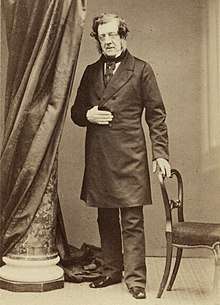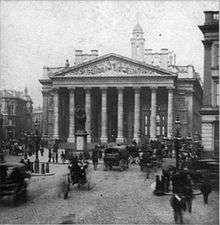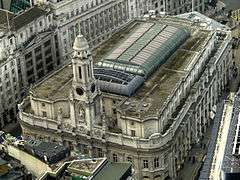William Tite
Sir William Tite CB FRS (7 February 1798 – 20 April 1873)[1] was an English architect who served as President of the Royal Institute of British Architects. He was particularly associated with various London buildings, with railway stations and cemetery projects. He was a Member of Parliament from 1855 until his death.
Sir William Tite CB FRS MP | |
|---|---|
 Tite photographed in Sussex in the 1860s | |
| Member of Parliament for Bath | |
| In office 5 June 1855 – 20 April 1873 | |
| Preceded by | Thomas Phinn |
| Succeeded by | Viscount Chelsea |
| Personal details | |
| Born | 7 February 1798 City of London, England |
| Died | 20 April 1873 (aged 75) Torquay, Devon, England |
| Political party | Liberal |
Early life and career
Tite was born in the parish of St Bartholomew the Great in the City of London,[2] in February 1798,[3] the son of a merchant in Russian goods named Arthur Tite.
He was articled to David Laing, architect of the new Custom House, and surveyor to the Parish of St Dunstan-in-the-East. Tite assisted Laing in the rebuilding of St Dunstan's church: according to an article published in the Architect in 1869, Tite entirely designed the new building, Laing himself having no knowledge of Gothic architecture.[2]
In 1827–8 Tite built the Scottish church in Regent Square, St Pancras, London, for Edward Irving,[3] in a Gothic Revival style, partly inspired by York Minster,[4] and ten years later collaborated with Charles Robert Cockerell in designing the London & Westminster Bank head office in Lothbury, also in the city.[3]
Royal Exchange

The rebuilding of the Royal Exchange, opened in 1844, was Tite's greatest undertaking.[3] The previous building was destroyed by fire in 1838, and a competition to design a replacement was held the following year. When this proved unproductive, a second limited competition was held between Tite, Charles Robert Cockerell, George Gwilt, Charles Barry and Robert Smirke. Tite's winning design has an imposing eight-column entrance portico, inspired by the Pantheon in Rome, while the other sides of the building are based on Italian renaissance models.[5]
Railway stations
Tite was the architect for the Eastern Counties, London and Blackwall, Gravesend and South Western Railways, and in France those between Paris and Rouen and Rouen and Le Havre; an article in the Architect named the station at Rouen, spanning nearly ninety feet, as an example of his structural skill.[2] Tite designed many of the early railway stations in Britain, including:[3]
- The termini of the London and South Western Railway at Vauxhall (Nine Elms), Southampton Terminus, Gosport and Windsor Riverside
- The termini of the London and Blackwall Railway at Minories and Blackwall (1840)
- Carnforth, Carlisle Citadel and Lancaster Castle railway stations (1846–1847)
- The majority of the stations on the Caledonian and Scottish Central railways, including Edinburgh (1847–1848) (not built) and Perth (1847–1848)
- Barnes, Barnes Bridge, Chiswick and Kew Bridge railway stations (1849)
- Stations between Yeovil and Exeter, including Axminster and the now-demolished Honiton.
His station at Carlisle was built in a neo-Tudor style with a frontage of about 400 feet, broken into several masses. At the centre of the façade was an arcade of five arches, with buttresses and pinnacles. The refreshment rooms had "an open timber roof, and oriels or bays, reminiscent of the dining-hall of olden times".[6]
Cemeteries

As a company director of the South Metropolitan Cemetery Company he laid out his first cemetery at Norwood in 1836 and designed several significant monuments and chapels there. While previous cemetery designs had followed a classical style, Tite's design was the first to employ the Gothic revival alongside landscaping, which was subsequently judged to be the archetype for future cemeteries.[7]
Between 1853 and 1854, with Sydney Smirke, he landscaped Brookwood Cemetery near Woking in Surrey for the London Necropolis Company. Maintaining his associations with railways, this cemetery was served by a dedicated train service from London Necropolis railway station, next to Waterloo station, in central London.[3]
Between 1858 and 1859 he built a memorial church in the Byzantine style at Gerrards Cross, Buckinghamshire.[3]
Later life
Tite's active work as an architect ceased about twenty years before his death[3] (in recognition of his contributions, however, he was awarded the RIBA Royal Gold Medal in 1856).
In 1851 he visited Italy after a grave illness. In 1854 he stood for parliament, unsuccessfully contesting Barnstaple as a Liberal, but the following year he was returned as Member of Parliament for Bath, which he represented until his death. He keenly opposed Sir George Gilbert Scott's proposal to build the new Foreign and Commonwealth Office and other government buildings adjacent to the Treaury in Whitehall in the Gothic style. He was knighted in 1869, and was made a Companion of the Bath the next year. Tite had a wide knowledge of English literature and was a good linguist and a lover of old books. He was an elected a fellow of the Royal Society in 1835, and of the Society of Antiquaries in 1839. He was President of the Camden Society and of the Royal Institute of British Architects.[2]
He was a director of the London and Westminster Bank and Governor of the Bank of Egypt; in 1856 he was nominated a member of the Select Committee on the Bank Charter. He was a member of the Metropolitan Board of Works, a magistrate of Middlesex and Somerset and Deputy-Lieutenant for London.[2] [3] He was also a Governor of St. Thomas's Hospital, London, where he is commemorated by the William Tite Scholarship, for the best student in the first year, with the highest aggregate marks in Anatomy and Physiology. After over 125 years, this prize has been subsumed into King's College London, where it is still awarded for excellence in the pre-clinical medical course.
He died on 20 April 1873 at Torquay and was interred in the catacombs of his South Metropolitan Cemetery.[8] Tite Street, which runs north-west from London's Chelsea Embankment, is named after him. Tite was a member of the Metropolitan Board of Works, largely responsible for the construction of Chelsea Embankment.
Gallery of architectural work
 Royal Exchange, London
Royal Exchange, London Aerial View, Royal Exchange, London
Aerial View, Royal Exchange, London- Portico, Royal Exchange, London
 Gothic entrance, West Norwood Cemetery
Gothic entrance, West Norwood Cemetery
Notes
- Goold, David. "Dictionary of Scottish Architects - DSA Architect Biography Report (November 14, 2018, 3:01 pm)". www.scottisharchitects.org.uk. Retrieved 14 November 2018.
- "Sir William Tite M.P." The Architect. 2: 27–8. 1869.
- Chisholm 1911, p. 1019.
- "National Scotch Church". UCL Bloomsbury Project. University College London. Retrieved 23 October 2012.
- Richardson, Albert E.; H. Stafford Bryant Jr (2001). Monumental Classic Architecture in Great Britain and Ireland. Courier Dover Publications. p. 97. ISBN 0-486-41534-1. Retrieved 22 June 2011.
- The British Almanac. 1849. p. 247.
- English Heritage The Register of Parks and Gardens: Cemeteries: "West Norwood (South Metropolitan Cemetery, 1837) saw the first cemetery buildings erected in the Gothic style (these being by William Tite) and from this point, Gothic Revival began to challenge Neo-Greek as the dominant style. By the mid 19th century, it was generally accepted that Gothic was the correct style for a Christian cemetery and for the latter part of the century onwards the great majority of cemetery buildings were in this manner"
- Obituary, The Architect, 26 April 1873, p. 225.
References
- S. P. Parissien Tite, Sir William (1798–1873) Oxford Dictionary of National Biography (subscription needed)
Attribution:

External links
- Hansard 1803–2005: contributions in Parliament by William Tite
- . Dictionary of National Biography. London: Smith, Elder & Co. 1885–1900.
- 41 Lothbury, London & Westminster Bank building, now refurbished as serviced offices
- Friend of West Norwood Cemetery
- Hansard 1803–2005: contributions in Parliament by William Tite
| Parliament of the United Kingdom | ||
|---|---|---|
| Preceded by George Treweeke Scobell and Thomas Phinn |
Member of Parliament for Bath 1855–1873 With: George Treweeke Scobell, to 1857 Sir Arthur Elton, 1857–1865 Arthur Edwin Way, 1859–1865 James Macnaghten McGarel-Hogg, 1865–1868 Donald Dalrymple from 1868 |
Succeeded by The Viscount Chelsea and Donald Dalrymple |